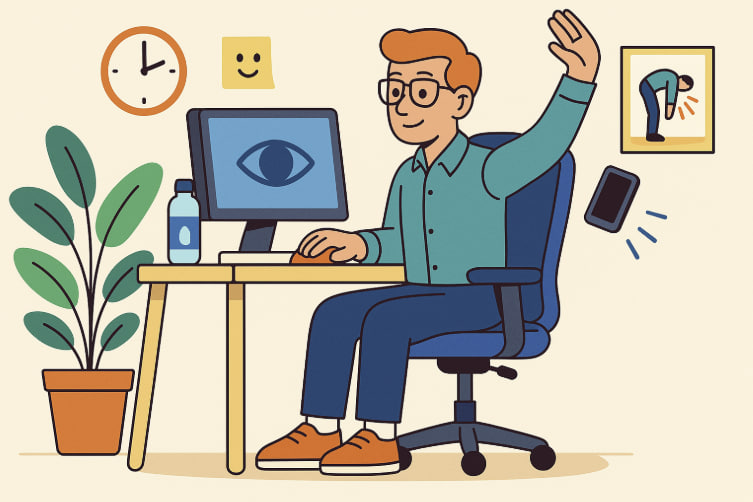In today’s digital world, many of us spend hours each day sitting in front of screens — whether at work, in school, or during leisure time. While technology increases efficiency, a sedentary lifestyle can take a toll on our health, posture, and mental well-being. If you work at a computer or have a desk job, these science-backed tips can help you stay healthy, focused, and energized throughout the day.
1. Set Up an Ergonomic Workspace
A well-organized workstation reduces physical strain and improves comfort. Key points:
- Monitor at eye level — Top of the screen should be at or slightly below eye level
- Chair support — Use a chair with proper lumbar support for your lower back
- Feet flat on the floor — Or use a footrest
- Keyboard and mouse at elbow height — Keep wrists straight and shoulders relaxed
- Use a headset for long calls to avoid neck strain
Investing in ergonomics prevents back pain, eye strain, and repetitive stress injuries.
2. Follow the 20-20-20 Rule for Eye Health
Staring at a screen for too long can cause digital eye strain, blurred vision, and dry eyes.
Use the 20-20-20 rule:
Every 20 minutes, look at something 20 feet away for at least 20 seconds.
Also:
- Blink often
- Adjust screen brightness and contrast
- Use blue light filters or glasses
3. Take Regular Movement Breaks
Sitting too long increases the risk of heart disease, obesity, and poor circulation. Counteract it by:
- Standing up every 30–60 minutes
- Doing light stretches (neck, shoulders, wrists, hips)
- Taking short walks (even around the room)
- Using a standing desk or adjustable workstation if possible
Regular motion boosts blood flow, focus, and productivity.
4. Watch Your Posture
Poor posture is a major cause of back, neck, and shoulder pain. Maintain:
- Straight spine, relaxed shoulders
- Elbows close to your body
- Hips aligned with knees
- Avoid crossing legs for long periods
Posture awareness improves comfort and reduces fatigue.
5. Stay Hydrated and Eat Smart
Dehydration can cause headaches, fatigue, and poor concentration.
- Keep a water bottle at your desk
- Limit caffeine and sugary drinks
- Snack on healthy options: nuts, fruits, veggies
- Don’t eat meals in front of the screen — take mindful food breaks
6. Stretch Daily and Exercise Regularly
In addition to micro-breaks, aim for at least 30 minutes of moderate activity a day:
- Walking, cycling, yoga, swimming
- Stretching after work to release muscle tension
- Try desk stretches for the shoulders, back, wrists, and legs
Movement improves circulation, posture, and mental clarity.
7. Protect Your Mental Health
Sedentary screen-based jobs can increase stress and anxiety. To maintain mental well-being:
- Schedule screen-free time during breaks and evenings
- Use mindfulness apps or breathing exercises to reduce stress
- Set work boundaries — define start and end times
- Connect with people offline to avoid isolation
Mental balance is as important as physical health.
Glossary
- Ergonomics — The science of designing a workspace to reduce discomfort and risk of injury
- Lumbar support — Cushioning that supports the lower back’s natural curve
- Digital eye strain — Discomfort from prolonged screen use, including dry eyes and blurred vision
- Sedentary lifestyle — A way of life with little physical activity
- Posture — The position in which you hold your body while sitting or standing


